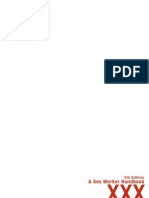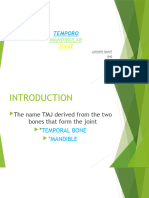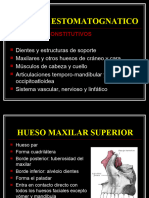0 ratings0% found this document useful (0 votes)
23 views17 TMJ (Done)
17 TMJ (Done)
Uploaded by
osamaeThe temporomandibular joint (TMJ) is a synovial joint between the temporal bone and mandible that allows for hinge and gliding movements. It is composed of the glenoid fossa, articular eminence, and condylar process. An articular disc divides the joint space into upper and lower compartments. The disc attaches to the condyle and aids movement. Surrounding ligaments and muscles like the masseter and lateral pterygoid also support the joint. Dysfunctions can cause issues like Costen's syndrome with symptoms of pain and ear problems.
Copyright:
© All Rights Reserved
Available Formats
Download as PDF, TXT or read online from Scribd
17 TMJ (Done)
17 TMJ (Done)
Uploaded by
osamae0 ratings0% found this document useful (0 votes)
23 views2 pagesThe temporomandibular joint (TMJ) is a synovial joint between the temporal bone and mandible that allows for hinge and gliding movements. It is composed of the glenoid fossa, articular eminence, and condylar process. An articular disc divides the joint space into upper and lower compartments. The disc attaches to the condyle and aids movement. Surrounding ligaments and muscles like the masseter and lateral pterygoid also support the joint. Dysfunctions can cause issues like Costen's syndrome with symptoms of pain and ear problems.
Original Title
17 TMJ (done)
Copyright
© © All Rights Reserved
Available Formats
PDF, TXT or read online from Scribd
Share this document
Did you find this document useful?
Is this content inappropriate?
The temporomandibular joint (TMJ) is a synovial joint between the temporal bone and mandible that allows for hinge and gliding movements. It is composed of the glenoid fossa, articular eminence, and condylar process. An articular disc divides the joint space into upper and lower compartments. The disc attaches to the condyle and aids movement. Surrounding ligaments and muscles like the masseter and lateral pterygoid also support the joint. Dysfunctions can cause issues like Costen's syndrome with symptoms of pain and ear problems.
Copyright:
© All Rights Reserved
Available Formats
Download as PDF, TXT or read online from Scribd
Download as pdf or txt
0 ratings0% found this document useful (0 votes)
23 views2 pages17 TMJ (Done)
17 TMJ (Done)
Uploaded by
osamaeThe temporomandibular joint (TMJ) is a synovial joint between the temporal bone and mandible that allows for hinge and gliding movements. It is composed of the glenoid fossa, articular eminence, and condylar process. An articular disc divides the joint space into upper and lower compartments. The disc attaches to the condyle and aids movement. Surrounding ligaments and muscles like the masseter and lateral pterygoid also support the joint. Dysfunctions can cause issues like Costen's syndrome with symptoms of pain and ear problems.
Copyright:
© All Rights Reserved
Available Formats
Download as PDF, TXT or read online from Scribd
Download as pdf or txt
You are on page 1of 2
Tempomandibular Joint
TMJ is synovial/ginglymoarrhrodial (hinge & sliding/ transverse
movement) joint between squamous part of the temporal part & mandible
The TMJ is composed of 3 parts:
1. Glenoid fossa of the temporal bone
Anteriorly: articular tubercle
Posteriorly: separated from the tympanic bone by the
squamotympanic fissure
Laterally: zygomatic arch
Medially: styloid process
2. Articular eminence of the temporal bone
3. Condyloid process of the mandible
Made of spongy bone with marrow & growth center
Articular region of the condyle is one of the most important
mandibular growth sites
The TMJ differs from other joints by the presence of avascular fibrous
tissue covering the articulating surface with an interposed meniscus
dividing the joint space into an upper & lower compartments
TMJ receives nourishment from the synovial membrane which is highly vascularized
Articular disc (meniscus):
Located Between the condyle and temporal bone
Fibrocartilagenous connective tissue that is thicker at the ends
The articular disc is attached to the condyle, so when the condyle glides forward and
backward, the disc moves with it.
The disc is avascular & aneural in the center (main load-bearing area) but vascular and
innervated at the periphery
Surrounding the articular disc is a fibrous capsule that encloses the entire joint.
The capsule is divided into upper and lower cavities by the disc; these cavities are filled
with synovial fluid.
The upper cavity is responsible for gliding movement
The Lower cavity is responsible for rotational movement
Supporting ligament:
temporomandibular ligament is the main supporting ligament
stylomandibular +sphenomandibular ligaments (have no function TMJ articulation)
Blood supply:
Superficial temporal artery; Maxillary artery: deep auricular artery; anterior tympanic artery
Sensory Innervation:
Auriculotemporal nerve
Masseter nerve
Posterior deep temporal nerve
Lateral pterygoid nerve
Costen Syndrome:
Due to TMJ abnormality usually due to impaired bite
Symptoms: Vertigo, Tinnitus, Feeling of Blocked ear, Otalgia, Frontal, parietal, occipital pain
Management: NSAIDs, hot compressors, slow exercise of the joint, bite correction by orthodontist
Muscles of TMJ (muscles of mastication):
Deep muscles: Lateral & medial pterygoid muscle:
the superior part of the lateral pterygoid muscle is inserted into the disk of TMJ
Lateral pterygoid muscle protract the mandible
Superficial muscles: Temporalis muscle, Masseter Muscles
Head of masseter Superficial head (larger part) Deep Head (smaller part)
Origin Inferior border of the anterior 2/3 of the Inferior border of the posterior 1/3 of the zygomatic arch
zygomatic arch Medial border of the zygomatic arch
Insertion Angle of the mandible Coronid process
Inferiolateral part of the mandible ramus Superiolateral mandibular ramus
Action Elevates the mandible Elevation
Muscle name Origin Insertion of the mandibule Direction of vector
Lateral pterygoid Infratemporal surface of the greater wings Capsule; TMJ Disc Horizontal-anterior
Lateral surface of the lateral pterygoid plate Neck of the condyle
Temporalis process Temporalis fossa Coroidal process Vertical-superior-posterior
Masseter process Zygomatic process Coroidal process Superficial fibers: Oblique
Mandibular ramus anterior
(superficial fibers: Deep fibers: Oblique
inferiolateral posterior
Deep fibers: superiolateral) Total fibers: Vertical superior
Medial pterygoid Medial surface of the lateral pterygoid Medial surface of Oblique anterior
the tuberosity of the maxilla &tubercle of mandibular angle
the palatine bone
Note unilateral excision of the condyle decrease the ability of the ipsilateral lateral pterygoid to open the mouth
This joint allows both gliding & hinge movement:
Gliding movement: in the upper compartment
between the temporal bone & meniscus
Hinge movement: in the lower compartment
between meniscus & condyle
What is normal interincisal opening? 40-50 mm.
You might also like
- John Jameson, Danny Bryden - Care of The Critically Ill Surgical Patient Student Handbook-The Royal College of Surgeons of England (2017)Document355 pagesJohn Jameson, Danny Bryden - Care of The Critically Ill Surgical Patient Student Handbook-The Royal College of Surgeons of England (2017)osamaeNo ratings yet
- TMJ PPT 130516130311 Phpapp02Document120 pagesTMJ PPT 130516130311 Phpapp02Hoang Nhan100% (2)
- Salah BulletDocument78 pagesSalah BulletosamaeNo ratings yet
- A Sex Worker Handbook, XXX GuideDocument47 pagesA Sex Worker Handbook, XXX GuideAB-75% (4)
- BS2001 Tutorial 1Document3 pagesBS2001 Tutorial 1cherlynNo ratings yet
- Tempomandibular Joint: Mandibular/glenoid FossaDocument4 pagesTempomandibular Joint: Mandibular/glenoid Fossaadham bani younesNo ratings yet
- GRDA Infratemporal FossaDocument10 pagesGRDA Infratemporal FossaKingNo ratings yet
- Temporomandibular Joint Disorder (TMD)Document76 pagesTemporomandibular Joint Disorder (TMD)DIPENDRA KUMAR KUSHAWAHANo ratings yet
- Temporomandibular Joint 3Document39 pagesTemporomandibular Joint 3successomahNo ratings yet
- Temporomandibular JointDocument28 pagesTemporomandibular JointAli Al-QudsiNo ratings yet
- Table A - TMJ and Infratemporal FossaDocument9 pagesTable A - TMJ and Infratemporal Fossaapi-422030113No ratings yet
- Temporomandibular Joint-Anatomy and Movement Disorders: ISSN: 2278 - 0211 (Online)Document12 pagesTemporomandibular Joint-Anatomy and Movement Disorders: ISSN: 2278 - 0211 (Online)Krupali JainNo ratings yet
- TMJ 2.0Document13 pagesTMJ 2.0Janvi RwtNo ratings yet
- Lecture 12 TMJDocument37 pagesLecture 12 TMJKIH 20162017No ratings yet
- Temporo: MandibularDocument38 pagesTemporo: MandibularyomanNo ratings yet
- Lagarto Homework TMJDocument10 pagesLagarto Homework TMJVarenLagartoNo ratings yet
- The MandibleDocument115 pagesThe MandiblenavjotsinghjassalNo ratings yet
- 3.musclesofmasticationseminar Aatika PDFDocument60 pages3.musclesofmasticationseminar Aatika PDFAbhishek GuptaNo ratings yet
- Tempromanndibular JointDocument10 pagesTempromanndibular Jointehab radmanNo ratings yet
- TMJ AnatomyDocument39 pagesTMJ AnatomyPravallika ManneNo ratings yet
- Muscles of Mastication &TMJDocument12 pagesMuscles of Mastication &TMJLisa Denton100% (1)
- Temporomandibular Joint: Joan S. SantosDocument9 pagesTemporomandibular Joint: Joan S. SantosVarenLagartoNo ratings yet
- Osteology of TibiaDocument17 pagesOsteology of TibiaTaro TariNo ratings yet
- The Temporomandibular JointDocument3 pagesThe Temporomandibular Jointumheba123No ratings yet
- tibiaboneDocument19 pagestibiaboneanikasinghahNo ratings yet
- Mandible, Temporomandibular Joint and Muscles of Mastication by ALGHAZALIDocument31 pagesMandible, Temporomandibular Joint and Muscles of Mastication by ALGHAZALIAbubakarNo ratings yet
- Temporomandibular Joint: Articular Glenoid FossaDocument9 pagesTemporomandibular Joint: Articular Glenoid FossaFatima MartinezNo ratings yet
- TMJ and Muscles of MasticatoryDocument9 pagesTMJ and Muscles of MasticatoryFatima MartinezNo ratings yet
- Bones Forming The JointDocument29 pagesBones Forming The JointvrajNo ratings yet
- TMJ 1 PDFDocument34 pagesTMJ 1 PDFmariam153265No ratings yet
- Examinationoftmjmusclesofmastication2 140115105518 Phpapp02Document79 pagesExaminationoftmjmusclesofmastication2 140115105518 Phpapp02Dr. Anjana MaharjanNo ratings yet
- Dr. Dinesh Kumar Yadav, KDCHDocument56 pagesDr. Dinesh Kumar Yadav, KDCHDinesh Kr. YadavNo ratings yet
- TMJ Surgical Anatomy and ApproachesDocument165 pagesTMJ Surgical Anatomy and Approachesmohammad ghouseNo ratings yet
- Osteology of Maxilla & Mandible Muscles of MasticationDocument26 pagesOsteology of Maxilla & Mandible Muscles of MasticationJaveria Khan100% (1)
- TM JointDocument22 pagesTM Jointapi-19916399No ratings yet
- Functions of MandibleDocument23 pagesFunctions of MandibleZeeshan AliNo ratings yet
- Temporomandibular Joint: DR Bhaumik Thakkar MDS-Part 1. Dept. of Periodontology and ImplantologyDocument60 pagesTemporomandibular Joint: DR Bhaumik Thakkar MDS-Part 1. Dept. of Periodontology and ImplantologyJoseph Eduardo Villar CordovaNo ratings yet
- Lecture 8 Temporal and Infratemporal FossaDocument8 pagesLecture 8 Temporal and Infratemporal Fossanatheer ayedNo ratings yet
- Anatomy of TMJ - PebrianDocument17 pagesAnatomy of TMJ - Pebriandikiprestya391No ratings yet
- TMJ AnatomiDocument53 pagesTMJ AnatomiNiTa DöéMy HarDianaNo ratings yet
- Muscular System March 2023 11Document95 pagesMuscular System March 2023 11ivy896613No ratings yet
- Mastction MusclesDocument41 pagesMastction Muscles1mohadanas1No ratings yet
- General Discription of MusclesDocument25 pagesGeneral Discription of Musclesapi-19641337No ratings yet
- Group 1 Arteries and Veins of The Head and Neck Temporomandibular JointsDocument92 pagesGroup 1 Arteries and Veins of The Head and Neck Temporomandibular JointsGuo YageNo ratings yet
- Lec.4 TMJ Part.1Document36 pagesLec.4 TMJ Part.1Haider Dhiya NooriNo ratings yet
- 1) Muscles of MasticationDocument75 pages1) Muscles of Masticationruchitiwari1541998No ratings yet
- Temporal Fossa & Infratemporal Fossa and Muscles of MasticationDocument22 pagesTemporal Fossa & Infratemporal Fossa and Muscles of Masticationpposs9220No ratings yet
- Tibiabone 220827070014 854ab62cDocument15 pagesTibiabone 220827070014 854ab62cdkokay48No ratings yet
- TMJ Seminar FinalDocument135 pagesTMJ Seminar FinalNamshi Ahamed100% (1)
- Sistema Estomatognatico y Palpacion MuscularDocument53 pagesSistema Estomatognatico y Palpacion Muscular5rztqhr4qnNo ratings yet
- Muscles PDFDocument34 pagesMuscles PDFHamad AnsariNo ratings yet
- Tempero Mandibular JointDocument30 pagesTempero Mandibular JointAkash AmbhoreNo ratings yet
- Biomechanics of Temporomandibular Joint and Cervical SpineDocument60 pagesBiomechanics of Temporomandibular Joint and Cervical SpineRitika SonyNo ratings yet
- Temporomandibular Joint-127273Document9 pagesTemporomandibular Joint-127273raxNo ratings yet
- Tempro-Mandibular Joint: - Can Be Classified Anatomically and Functionally A-AnatomicallyDocument25 pagesTempro-Mandibular Joint: - Can Be Classified Anatomically and Functionally A-AnatomicallySamwel Emad100% (1)
- Assignment 8Document34 pagesAssignment 8nivitha naiduNo ratings yet
- 7. Arm and elbowDocument11 pages7. Arm and elbowcbelludiNo ratings yet
- Mom SeminarDocument75 pagesMom SeminarESHWAR KHANNo ratings yet
- TMJ Seminar FinalDocument135 pagesTMJ Seminar FinalrayaimNo ratings yet
- Gray's Anatomy: Anatomy Descriptive and SurgicalFrom EverandGray's Anatomy: Anatomy Descriptive and SurgicalRating: 1 out of 5 stars1/5 (1)
- A Guide for the Dissection of the Dogfish (Squalus Acanthias)From EverandA Guide for the Dissection of the Dogfish (Squalus Acanthias)No ratings yet
- A Simple Guide to the Ear and Its Disorders, Diagnosis, Treatment and Related ConditionsFrom EverandA Simple Guide to the Ear and Its Disorders, Diagnosis, Treatment and Related ConditionsNo ratings yet
- Ent Uk FilesDocument58 pagesEnt Uk FilesosamaeNo ratings yet
- Consent by DR SalahDocument5 pagesConsent by DR SalahosamaeNo ratings yet
- FomaDocument1,218 pagesFomaosamaeNo ratings yet
- Psychiatry - Plab2Aspired19Document47 pagesPsychiatry - Plab2Aspired19osamaeNo ratings yet
- 25 Middle Ear, Ossicles, Eustachian Tube (Done)Document17 pages25 Middle Ear, Ossicles, Eustachian Tube (Done)osamaeNo ratings yet
- ExaminationDocument11 pagesExaminationosamaeNo ratings yet
- Ethical Plab2Aspired19Document122 pagesEthical Plab2Aspired19osamaeNo ratings yet
- Counselling Plab2Aspired19Document137 pagesCounselling Plab2Aspired19osamaeNo ratings yet
- 18 Tonsil, Adenoid Notes Cumming Abd Key Topics (New Moe)Document7 pages18 Tonsil, Adenoid Notes Cumming Abd Key Topics (New Moe)osamaeNo ratings yet
- 19 1st RibDocument3 pages19 1st RibosamaeNo ratings yet
- 29 DiathermyDocument2 pages29 DiathermyosamaeNo ratings yet
- 16 The Mouth (Done)Document9 pages16 The Mouth (Done)osamaeNo ratings yet
- 24 Inner Ear Anatomy, Emberyology, Drugs Ototoxicity (Done)Document24 pages24 Inner Ear Anatomy, Emberyology, Drugs Ototoxicity (Done)osamaeNo ratings yet
- 23 External Ear (Done)Document4 pages23 External Ear (Done)osamaeNo ratings yet
- 2 Head and NeckDocument45 pages2 Head and NeckosamaeNo ratings yet
- 20 MiscDocument5 pages20 MiscosamaeNo ratings yet
- 22 Blood Supply of The Ear - DoneDocument7 pages22 Blood Supply of The Ear - DoneosamaeNo ratings yet
- 1 The EsophagusDocument9 pages1 The EsophagusosamaeNo ratings yet
- CPD ObgDocument12 pagesCPD ObgArjun RameshNo ratings yet
- Part 6 Thinking Straight PDFDocument18 pagesPart 6 Thinking Straight PDFnanuflorinaNo ratings yet
- Processing of The Phonocardiographic Signal Methods For The Intelligent StethoscopeDocument89 pagesProcessing of The Phonocardiographic Signal Methods For The Intelligent StethoscopeHaleemaMalikNo ratings yet
- Young Talk, February 2009Document4 pagesYoung Talk, February 2009Straight Talk FoundationNo ratings yet
- Avian Influenza (Highly Pathogenic) : Fowl Plague, Fowl Pest, Brunswick Bird Plague, Fowl Disease, Fowl or Bird GrippeDocument23 pagesAvian Influenza (Highly Pathogenic) : Fowl Plague, Fowl Pest, Brunswick Bird Plague, Fowl Disease, Fowl or Bird Grippehericonan9100% (1)
- Try Septiyando SinagaDocument25 pagesTry Septiyando SinagatryseptiandosinagaNo ratings yet
- Exam Practice 1Document2 pagesExam Practice 1Filibelen GonzalezNo ratings yet
- AnimalsDocument6 pagesAnimalskaito kidNo ratings yet
- CHAPTER 13 Effector Mechanisms of Humoral ImmunityDocument21 pagesCHAPTER 13 Effector Mechanisms of Humoral ImmunitySri Sulistyawati AntonNo ratings yet
- Ectoparasites of The Nile Rat, Arvicanthis Niloticus From Shendi Area, SudanDocument6 pagesEctoparasites of The Nile Rat, Arvicanthis Niloticus From Shendi Area, SudanWISNU ARYO ANGGORO 1No ratings yet
- 05 Fisiologia Comp Dig Adapt Digestivas - UnlockedDocument61 pages05 Fisiologia Comp Dig Adapt Digestivas - UnlockedManuel GarciaNo ratings yet
- Gynecological Anatomy & PhysiologyDocument39 pagesGynecological Anatomy & Physiologynursereview100% (4)
- Bloat in RabbitDocument4 pagesBloat in RabbitAmik DonissaNo ratings yet
- Gallus Gallus DomesticusDocument4 pagesGallus Gallus DomesticusyvonneymNo ratings yet
- 3 MicrobiologíaDocument30 pages3 MicrobiologíaJohan RosarioNo ratings yet
- Ebooks File Advances in Comparative Immunology Edwin L. Cooper All ChaptersDocument62 pagesEbooks File Advances in Comparative Immunology Edwin L. Cooper All Chaptersdejacigismo100% (3)
- Gambaran Status Kebersihan Gigi Dan Mulut Pada Pengidap HIV/AIDS Di Yayasan Batamang Plus BitungDocument5 pagesGambaran Status Kebersihan Gigi Dan Mulut Pada Pengidap HIV/AIDS Di Yayasan Batamang Plus BitungWidya Sri IswariNo ratings yet
- Serologic Chart V 8Document1 pageSerologic Chart V 8Olga CîrsteaNo ratings yet
- MCQ On Menstrual CycleDocument7 pagesMCQ On Menstrual CycleKarishma Shroff100% (7)
- Histology of The EyeDocument32 pagesHistology of The EyehendriNo ratings yet
- Bioexplorer NetDocument7 pagesBioexplorer NetAprilMartelNo ratings yet
- Zentel™ Albendazole: Page 1 of 5Document5 pagesZentel™ Albendazole: Page 1 of 5zain qadriNo ratings yet
- Dennie-Morgan Fold Plus Dark Circles: Suspect Atopy at First SightDocument1 pageDennie-Morgan Fold Plus Dark Circles: Suspect Atopy at First Sight2readNo ratings yet
- 1 - Dental Anatomy 101 Dant PDFDocument42 pages1 - Dental Anatomy 101 Dant PDFRamez Rimez100% (1)
- Body Fluid Compartment and Formation of Edema 1Document4 pagesBody Fluid Compartment and Formation of Edema 1JayricDepalobosNo ratings yet
- DermatologyDocument44 pagesDermatologymumunooNo ratings yet
- Nursing Basics Vital SignsDocument22 pagesNursing Basics Vital SignsTee WoodNo ratings yet
- Histo Anat D&R AgamDocument26 pagesHisto Anat D&R AgamuvuvivbjsjsnsnibNo ratings yet













































































































